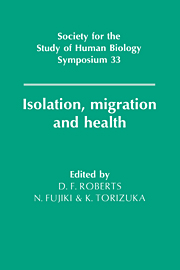Book contents
- Frontmatter
- Contents
- List of contributors
- Preface
- 1 The legacy of the IBP: Presidential Address
- 2 The distinction between primary and secondary isolates
- 3 Time trends in the break-up of isolates
- 4 Factors influencing the frequency of consanguineous marriages in Japan
- 5 Break-up of isolates
- 6 Isolates in India: their origin and characterisation
- 7 Consanguineous marriages and their genetical consequences in some Indian populations
- 8 Biomedical and immunogenetic variation in isolated populations in India
- 9 Genetic distance analyses in Israeli groups using classical markers and DNA polymorphisms in the β globin gene
- 10 Non-random distribution of Gm haplotypes in northern Siberia
- 11 Allele frequency estimation
- 12 Genetic affinities of human populations
- 13 Inherited neurological diseases in island isolates in southern Japan
- 14 Serological and virological evidence for human T-lymphotropic virus type I infection among the isolated Hagahai of Papua New Guinea
- 15 Analysis of genes associated with hypercholesterolaemia in the Japanese population
- 16 Migrant studies and their problems
- 17 Tokelau: migration and health in a small Polynesian society - a longitudinal study
- 18 Micromigrations of isolated Tuareg tribes of the Sahara Desert
- 19 Population structure in the eastern Adriatic: the influence of historical processes, migration patterns, isolation and ecological pressures, and their interaction
- 20 Diabetes and diabetic macroangiopathy in Japanese-Americans
- 21 Diabetes and westernisation in Japanese migrants
- 22 Environmental factors affecting ischemic heart disease
- Epilogue
- Index
5 - Break-up of isolates
Published online by Cambridge University Press: 05 March 2012
- Frontmatter
- Contents
- List of contributors
- Preface
- 1 The legacy of the IBP: Presidential Address
- 2 The distinction between primary and secondary isolates
- 3 Time trends in the break-up of isolates
- 4 Factors influencing the frequency of consanguineous marriages in Japan
- 5 Break-up of isolates
- 6 Isolates in India: their origin and characterisation
- 7 Consanguineous marriages and their genetical consequences in some Indian populations
- 8 Biomedical and immunogenetic variation in isolated populations in India
- 9 Genetic distance analyses in Israeli groups using classical markers and DNA polymorphisms in the β globin gene
- 10 Non-random distribution of Gm haplotypes in northern Siberia
- 11 Allele frequency estimation
- 12 Genetic affinities of human populations
- 13 Inherited neurological diseases in island isolates in southern Japan
- 14 Serological and virological evidence for human T-lymphotropic virus type I infection among the isolated Hagahai of Papua New Guinea
- 15 Analysis of genes associated with hypercholesterolaemia in the Japanese population
- 16 Migrant studies and their problems
- 17 Tokelau: migration and health in a small Polynesian society - a longitudinal study
- 18 Micromigrations of isolated Tuareg tribes of the Sahara Desert
- 19 Population structure in the eastern Adriatic: the influence of historical processes, migration patterns, isolation and ecological pressures, and their interaction
- 20 Diabetes and diabetic macroangiopathy in Japanese-Americans
- 21 Diabetes and westernisation in Japanese migrants
- 22 Environmental factors affecting ischemic heart disease
- Epilogue
- Index
Summary
At present mankind is experiencing a formidable demographic revolution. World population is increasing fast, mortality before and during reproductive age is being reduced, and traditional patterns of marriage are disappearing. One aspect of this demographic revolution of particular interest in population genetics is the break-up of isolates.
For millions of years, our predecessors lived in small population groups, often consisting of fewer than one hundred individuals. Each of these groups was to some extent isolated from others and usually marriage occurred within the group, sometimes between subgroups. As a consequence, their genetic composition changed relatively quickly, depending on chance fluctuations of gene frequencies, and to a certain degree under the influence of changing patterns of natural selection.
Effects of isolation
Whereas in an infinitely large, randomly mating population the frequency (q) of a given allele depends on its mutation rate and selective advantage or disadvantage, its frequency in a small population is greatly affected by chance - provided only that its selective disadvantage is not too strong. Figure 5.1 shows the distribution of the frequency of an allele (initial mean q = 0.5) at a diallelic locus in groups of populations depending on their effective sizes largely determined by the number of couples breeding. Mutation rates and back mutation rates are assumed to be identical. With small population size (a), many populations will be homozygous for one of the two alleles (q = 0 or 1) whereas, for very large populations, q clusters around 0.50. An allele may become homozygous (= fixed) in a small population by chance fluctuation in frequency even against a certain selective disadvantage (Figures 5.2 and 5.3).
- Type
- Chapter
- Information
- Isolation, Migration and Health , pp. 41 - 54Publisher: Cambridge University PressPrint publication year: 1992
- 2
- Cited by



